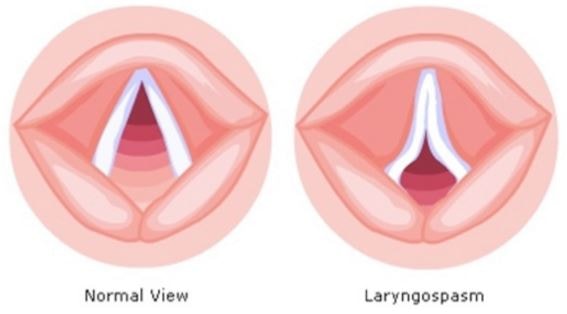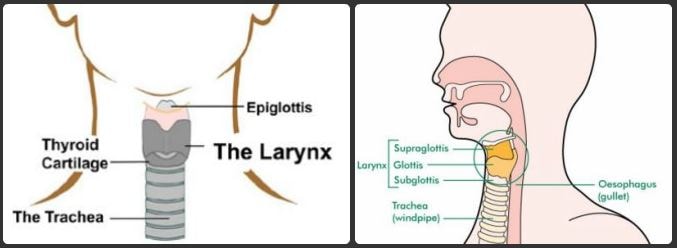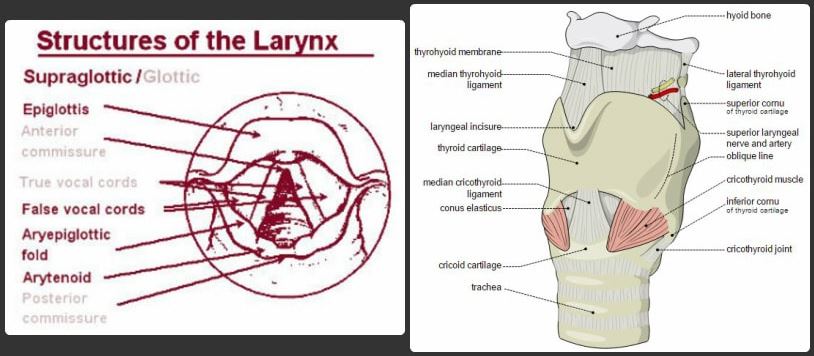Laryngospasm
What is laryngospasm?
Laryngospasm is a temporary uncontrollable, involuntary or abnormal muscle contraction of the larynx with the onset of less than a minute. It is an alarming condition because it constricts the passage airway, resulting to lesser oxygen supply getting into the lungs, making the person having the difficulty to breathe; but in some worst cases, the larynx could completely close or block the passage airway.

The larynx is located in the upper respiratory tract consisting of the epiglottis, a valve flap of cartilage that covers the opening to the larynx; the glottis is the notch between the vocal cords in the larynx; cricoid cartilage complete cartilaginous ring in the larynx; thyroid cartilage is the largest, part of the Adams apple; and the arytenoid cartilage which utilizes vocal cord movement with the thyroid cartilage.

Image 2 – Location of larynx

Image 3 – Parts of larynx and Larynx related structures
The main function of the larynx is for vocalization and protection of the lower respiratory tract from foreign substances; it also facilitates coughing reflex.
Causes
The etiology of Laryngospasm is still idiopathic; but it has been discovered that laryngospasm is usually a complication of other underlying disease condition like:
- Gastroesophageal Reflux Disease (GERD) is a disease condition in which the acidic gastric juices in the stomach backflows to the esophagus. Excessive reflux of acidic gastric juice can lead to irritation and inflammation to the sensitive lining of the esophagus, spasm then happens causing constriction of the airway, less oxygen getting inside the lungs, difficulty breathing occurs.
- Laryngopharyngeal reflux (LPR) happens when the acidic gastric juices reaches to the larynx, it could irritate and cause inflammation because tissues of the larynx are much more delicate compared to the esophagus.
- Complication after surgery, the spasm may occur due to irritation from endotracheal tube or from anesthetic agent and gases. Laryngospasm also happen after the removal of endotracheal tube.
- Other probable causes of laryngospasm are allergic reactions and infection of the throat due to foreign bodies and epiglottitis.
Symptoms of laryngospasm
Individuals who are having laryngospasm manifest Gastroesophageal Reflux Disease (GERD) symptoms. The clinical manifestations are:
- Stridor or crowning respiration– a harsh vibrating sound or a coarse and high-pitched sound heard during respiration in cases of constricted muscle in the airway. You hear stridor by listening over the trachea with the use of stethoscope.
- Pyrosis or Heartburn- a burning and tight sensation that is felt intermittently beneath the lower sternum and spreads upward to the throat or jaw that is due to excessive gastric juice reflux.
- Dysphagia– difficulty swallowing or painful to swallow.
Other symptoms include sore throat, regurgitation, nausea and coughing.
Treatment
The course of treatment depends on the underlying causes; managing the underlying cause first well help resolve or prevent the occurrence of laryngospasm. If Gastroesophageal Reflux Disease (GERD) and Laryngopharyngeal reflux (LPR) is the underlying cause; managing it first helps prevent the occurrence of the condition.
Lifestyle modification to prevent laryngospasm:
-change diet to low-fat
-avoid eating oily and fatty foods
-avoid drinking caffeine content, carbonated beverages and foods containing spicy, peppermint and spearmint
-avoid consuming food or drinking water or any beverages, 2 hours before bed
-avoid lying down after eating and drinking
-exercise regularly
-avoid smoke or if do you smoke stop as early as possible
-lessen alcohol consummation
-for bed ridden clients, raise the bed to semi to high frowlers position, let it stay for 1-3hours after meal.
Medical management
- Antacids it neutralizes the stomach, it relieves heartburn quickly but in a short break. This should be taken 1-3hours AFTER meal and at bedtime.
- H2 Blockers it decreases the secretion Hydrochloric Acid in the stomach through blocking enzyme.
- Proton Pump Inhibitors it inhibits the proton pump mechanism responsible for secretion of H ions. It also promote healing of the esophagus and beneficial in decreasing the incidence laryngospasm. This should be take 1-2hours BEFORE meal. Sad to say but more expensive compare to Antacid and H2 blocker
Treating Laryngospasm that is cause by Anesthetic agent in Surgery room:
- Hyperextend the patient’s neck and administer positive pressure ventilation of oxygen
- Administration of intravenous muscle relaxant like Succinylcholine
- Administering corticosteroid to lessen the inflammation
- And Possible Reintubation
In minor cases Laryngospasm will generally resolve impulsively by keeping calm, breathe in slowly, inhale to your nose exhale to your mouth. Drink plenty of water to drain irritants that cause the spasm of your larynx.
Complications
When Laryngospasm left untreated, infection and inflammation gets into worst and it could completely close the airway due to severe spasm, no oxygen can get into the lungs, where breathing now is useless and it will surely end to death.
References
Source:
- http://www.webmd.boots.com/heartburn-gord/guide/laryngospasm-causes-symptoms-and-treatments Medically Reviewed by Dr Rob Hicks
- http://www.mayoclinic.org/diseases-conditions/gerd/expert-answers/laryngospasm/faq-20058269 by Edward C. Rosenow III, M.D.
- https://en.wikipedia.org/wiki/Laryngospasm
Books:
- Black, Joyce and Hawks. (2009).Medical surgical nursing: Clinical management for positive outcomes. (8th edition). Singapore: W.B Saunders Company.
- Smeltzer, S., Bare, B. et. al. (2004). Brunner & Suddarths’s medical surgical nursing, Vol. 1, (11th edition). New York: Lippincott Williams & Wilkins.
- Mevorach DL. (1996) The management and treatment of recurrent postoperative laryngospasm. Anaesth Analg
